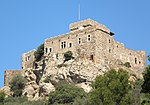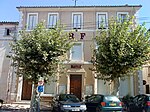Château de Gaussan
Castles in AudeFrench castle stubsMonuments historiques of Aude

The Château de Gaussan is a castle, much altered in the 19th century, in the commune of Bizanet in the Aude département of France. The castle dates originally from the 14th century. It is particularly noted for the east and south façades and their corresponding roofs, the staircase, the interior decor of the library and the great hall of the corps de logis, as well as the 19th century chapel and 14th century lower hall. The Château de Gaussan is privately owned. It has been listed since 1986 as a monument historique by the French Ministry of Culture.
Excerpt from the Wikipedia article Château de Gaussan (License: CC BY-SA 3.0, Authors, Images).Château de Gaussan
D 423, Narbonne
Geographical coordinates (GPS) Address Nearby Places Show on map
Geographical coordinates (GPS)
| Latitude | Longitude |
|---|---|
| N 43.135277777778 ° | E 2.8422222222222 ° |
Address
Monastère Notre-Dame de Gaussan
D 423
11200 Narbonne
Occitania, France
Open on Google Maps









